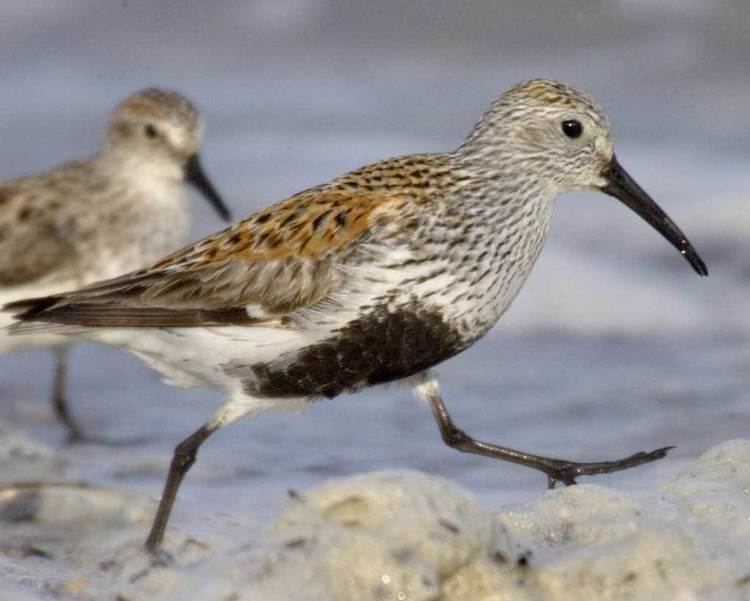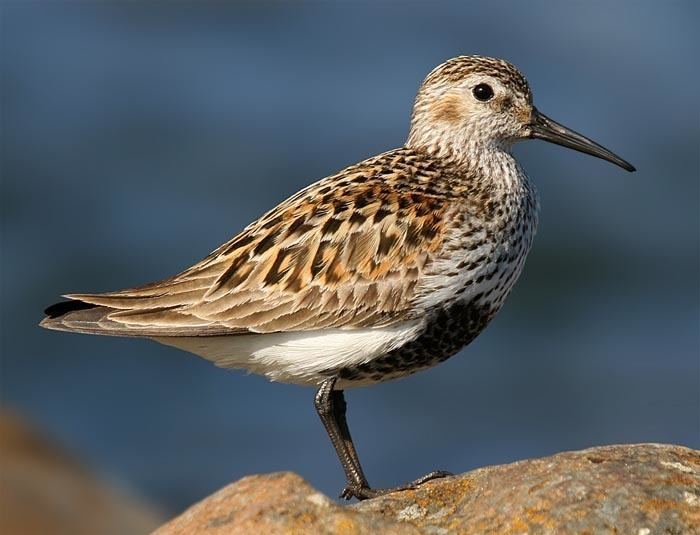Higher classification Calidrid Rank Species | Family Scolopacidae Phylum Chordata Order Shorebirds | |
 | ||
Similar Bird, Sandpiper, Calidrid, Sanderling, Common ringed pl | ||
Bto bird id knot and dunlin
The dunlin (Calidris alpina) is a small wader, sometimes separated with the other "stints" in Erolia. The English name is a dialect form of "dunling", first recorded in 1531–2. It derives from "dun", "dull brown ", with the -ling suffix meaning "concerned with". The genus name is from Ancient Greek kalidris or skalidris, a term used by Aristotle for some grey-coloured waterside birds. The specific alpina is from Latin and means "of high mountains", in this case referring to the Alps.
Contents

It is a circumpolar breeder in Arctic or subarctic regions. Birds that breed in northern Europe and Asia are long-distance migrants, wintering south to Africa, southeast Asia and the Middle East. Birds that breed in Alaska and the Canadian Arctic migrate short distances to the Pacific and Atlantic coasts of North America, although those nesting in northern Alaska overwinter in Asia. Many dunlins winter along the Iberian south coast.
Behaviour

The dunlin is highly gregarious in winter, sometimes forming large flocks on coastal mudflats or sandy beaches. Large numbers can often be seen swirling in synchronized flight on stop-overs during migration or on their winter habitat.
This bird is one of the most common waders throughout its breeding and wintering ranges, and it is the species with which other waders tend to be compared. At 17–21 cm (6.7–8.3 in) length and with a 32–36 cm (13–14 in) wingspan, it is similar in size to a common starling, but stouter, with a thicker bill.
The dunlin moves along the coastal mudflat beaches it prefers with a characteristic "sewing machine" feeding action, methodically picking small food items. Insects form the main part of the dunlin's diet on the nesting grounds; it eats molluscs, worms and crustaceans in coastal areas.
Description
An adult dunlin in breeding plumage shows the distinctive black belly which no other similar-sized wader possesses. The winter dunlin is basically grey above and white below. Juveniles are brown above with two whitish "V" shapes on the back. They usually have black marks on the flanks or belly and show a strong white wingbar in flight.
The legs and slightly decurved bill are black. There are a number of subspecies differing mainly in the extent of rufous colouration in the breeding plumage and the bill length. Bill length varies between sexes, the females having longer bills than the males.
Subspecies
Nesting
The nest is a shallow scrape on the ground lined with vegetation, into which typically four eggs are laid and incubated by the male and female parents. Chicks are precocial, however are brooded during early development. They start to fly at approximately three weeks of age. The majority of brood care is provided by the male, as the female deserts the brood and often leaves the breeding area.
The call is a typical sandpiper "peep", and the display song a harsh trill.
The dunlin is one of the species to which the Agreement on the Conservation of African-Eurasian Migratory Waterbirds (AEWA) applies.
Apparent hybrids between this species and the white-rumped sandpiper as well as with the purple sandpiper have been reported from the Atlantic coasts of North America and Europe, respectively.
